
Planet/Cuba. On Jorge Enrique Lage's Carbono 14: Una novela de culto and Vultureffect(1)
Rachel Price, Princeton University
Might post-revolutionary culture mean a move from an imaginary of Cuba as a small island nation with delusions of world historical grandeur to Cuba as a mere archipelago on a shrinking planet?(2) Such a transition caps the past century's progression from Cuba as Davidic protector of the Americas (Martí) to satellite of Cold War powers and site of futuristic fantasies, to a Special Period Planet Cuba (one more commodified experience; Buena Vista Social Club meets Planet Hollywood). More than a decade into the twenty-first century we have perhaps left all that behind for something like Planet/Cuba, a relation that reflects both global environmental concerns and the specific challenges of one small nation among many others.
 Such a transition is suggested fantastically in Cuban author Jorge Enrique Lage's Carbono 14: una novela de culto, a delirious mash-up of pulp genres (fanfic, science fiction, pop music, detective fiction, manga, television series) nominally about a tween who falls from an exploding planet, home to the Cubans, through outer space and into a post-communist city named La Habana (LH) on planet V. (Carbono 14 was published by the Peruvian Ediciones Altazor in 2010, and is slated to come out with Letras cubanas in late 2012 or early 2013).
Such a transition is suggested fantastically in Cuban author Jorge Enrique Lage's Carbono 14: una novela de culto, a delirious mash-up of pulp genres (fanfic, science fiction, pop music, detective fiction, manga, television series) nominally about a tween who falls from an exploding planet, home to the Cubans, through outer space and into a post-communist city named La Habana (LH) on planet V. (Carbono 14 was published by the Peruvian Ediciones Altazor in 2010, and is slated to come out with Letras cubanas in late 2012 or early 2013).
Among contemporary Cuban authors Lage's work is notable for its total fusion of styles, though it should be situated alongside writing by authors anchored in more canonical science fiction or cyberpunk traditions, such as Raúl Aguiar, Raúl Flores, Erick Mota, Yoss, and Daína Chaviano, several of whom Lage has worked with at the Centro de Formación Literaria Onelio Jorge Cardoso.(3) Echoing earlier Cuban science fiction that conjured future La Habanas, Carbono 14's city boasts skyscrapers and a completed metro (similarly imagined in the 1985 novel Confrontación, just when actual plans for a subway were hatched and scuttled) but adds to its rather dystopian city a thriving industry of porn series and “irreality” shows filmed by a couple of brothers from Hong Kong. The murderous, pornographic, extraterrestrial/fallen Cuban is quickly baptized “Evelyn” by the inhabitants of LH and joins a series of other Evelyns as an actress on a television series named “Prehistorias,” while struggling to remember details of her home.
“Prehistorias,” evoking Evelyn's prehistoric home, is produced by the brothers Fei and Akuma Long. The Longs are ostensibly from Xianggang (Hong Kong), though they are something closer to caricatures of pan-Asian pop culture, since Akuma — “demon” in Japanese — is the name of a Japanese Street Fighter character. "Xianggang" though, like much in the novel, is not so much a real referent as a slightly more futuristic twin of this futuristic LH: an island city-state operating in the shadow of a giant power, with a history of occupation by a number of empires, whose national sovereignty seems less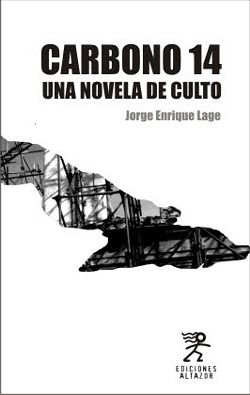 important than its own financial development; a center for the production of highly exportable action flicks of the Jackie Chan/John Woo kind.
important than its own financial development; a center for the production of highly exportable action flicks of the Jackie Chan/John Woo kind.
The set for the Long brothers' series of television series is a microcosmic mirror for the novel's post-production, virtual Havana, assembled through Final Cut Pro to approximate “irreality:” “todo se rodaba en interiores. Sobres espacios n-dimensionales en blanco que al mismo tiempo podían ser azules, rosados, etc. Los espacios exteriores no se manipulan: se inventan. Sobre todo si ya existen como espacios posibles en algún exterior de la ciudad. Porque la ciudad también se inventa. Una y otra vez" (29-30). As a miniature stage for the novel's exterior setting, the irreality shows highlight the total convergence and sampling of media today, a "paquete mediático que incluye misterio, rumores, premieres, entrevistas en vivo y en texto, flashes de fotógrafos, eventos promocionales, etcétera. Algarabía de fans” (36). The television series then showcase Carbono 14's own riff on genre fiction. In both style and content the novel comments on the increasing decentralization of artistic production. By thematizing fanfic — fiction written by fans who build on pre-existing novels, usually genre fiction — Carbono 14points to an increasing eclipse of the single author and celebration of her wake (“algarabía de fans”) as the logical result of new media platforms like youtube and microblogging sites: Cortázar's killer fans updated.
As Evelyn attempts to remember her past, protagonist “JE” (who shares the author's initials) pursues his obsession: using a DIY carbon-14 radiometric dating kit to determine the age of women's lingerie (ropa interior and by extension, interiority) as well as the era of the strange LH he inhabits. The carbon-14 kit is a phallic prosthesis with which JE pokes but does not impregnate his paramours. Instead he uses the kit to steal from them important information in a parody of biopolitical control: our sexuality and, ultimately, our time are the last but most crucial spaces of control. Matching JE's kit is the only article with which Evelyn arrives onto planet V: a Tabla periódica de los elementos. The Tabla is an enigma, a machine of codes, and a kind of tablet computer boasting “una pantalla flexible y sensible” (43). It offers gnomic, Oujia board-like pronouncements. As a guide to the exploded planet's elements, it may offer either a code to the old planet Cuba or a guide for constructing a new one.
Read together, the Tabla periódica and the Carbon 14 kit indicate some of the book's most pressing questions: What exactly is being dated and measured in Carbono 14? What concept of periodization are we working with here — a here that includes both the science fiction Havana of the novel, the real Havana of 2010 when the book was published, and the ever-more synchronic, networked planet more broadly? Is this an archaeology of a Cuban present burdened by its past? An archaeology of a global digital age?
In addition to meditations on temporality, the tabla highlights Carbono 14's interest in code. The novel's deadpan nonrealism, which aspires neither to allegorical satire nor the faithful creation of an alternative reality, marries cyberpunk's concerns with prosthetic bodies and cybernetics to recent, more “high” literature's genre- (and species-) bending as manifested in recent writing by César Aira (with its improbable murders and indeterminately gendered characters) and Mario Bellatín (whose Biografía ilustrada de Mishima, for example, stars a posthumous, decapitated Yukuo Mishima cogitating on voids, limbs, and the deceptive realism of photography).
Like these authors Lage is concerned with the mutability of the human body and species and with the fate of cultural production in an era of mash-ups, in which writing details not always interiority but superficie, and in which seriality is not only a dominant form but also content. These concerns are echoed in Lage's 2011 book of micronarratives entitled Vultureffect. But while both Carbono 14 and Vultureffect qualify as the kind of post-national, global contemporary fiction Spanish critic Eloy Fernández Porta has termed “afterpop,” Lage also maintains an inescapably Cuban framework, and his work can also be read as a meditation on temporality in twenty-first century Cuba, as well as a speculation about post-revolutionary Cuba; indeed about a post-Cuba: about how to live on the island with a planetary consciousness.
Tablas periódicas
From the novel's first page fragments are held up as a kind of new ontology.(4) The naked Evelyn plunges to planet V with the fragments of a galactic, Sarduyean "Big Bang" all but clinging to her. She lands in a new world “entre fragmentos” of a more mediatic nature: tv series, advertisements, irreality shows (11). What at the beginning of the twentieth century might have suggested modernist fracturing, and at its end the rubble of ruins, here appear as fragments characteristic of a recent kind of recombinant writing that Kenneth Goldsmith has termed “uncreative:” a writing that repurposes pieces of music, television, film, video games, and language already circulating through digital exchanges. As Goldsmith writes, “[w]hen cutting and pasting are integral to the writing process, it would be mad to imagine that writers wouldn't exploit these functions in extreme ways” (5).
As the dust settles about her, Evelyn asks herself what purpose the Tabla may have served in her native Cuba. A year before Carbono 14 was published, Lage's Tabla inspired a similar figure in a book by his friend Orlando Luis Pardo Lazo, whose 2009 collection Boring Home offered on its last page, in lieu of narrative, a “Tabula híperiodica” whose positions on the typical chemistry chart of elements were filled not by chemicals related to their neighbors but keywords from discourses linked to the revolution or to contemporary Cuban culture: “libertad,” “contrarrevolucionario,” “heroes,” and so on (73). For a while, Lage has noted, the two friends amused themselves classifying all manner of ideas into such “tablas” in an almost Cabrera Infantesque game of ordering contemporary culture and ideologies.
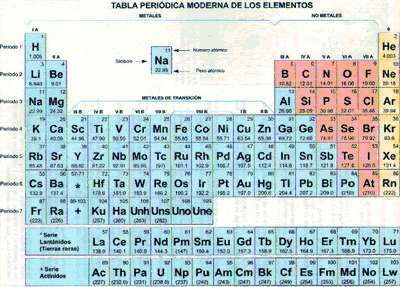 Lage's Tabla however goes beyond Pardo's more local lexicon and positions itself in a long history of code processing machines, from Alan Turing's proto-computer to the Ipad (Turing returns as a character in Vultureffect). And the Tabla's immediate appearance in Carbono-14's first pages highlights its singular fusion of the novel's central concerns: namely, writing/code/genre, and the question of how to figure a post-Castro Cuba whose future is planetary. But if the Tabla enshrines a code, what past or future does it unlock? Does its inscrutability in the Havana of planet V suggest the irrelevance of revolutionary catechisms for other times and places, as Pardo's Tabula hiperperiódica does? A passage late in Carbono 14 supports this idea, when a description of planet Cuba's explosion has its inhabitants catapulted through space, “sus manos aferradas a la Tabla Periódica como única tabla de salvación, todo como un gran sueño intergaláctico que no comprendes y del que nunca te despiertas del todo” (140). Here the Table is a map that can provide no orientation, clung to out of fear, printed with the elements with which to begin again — but not, surely, in order to build the same future.
Lage's Tabla however goes beyond Pardo's more local lexicon and positions itself in a long history of code processing machines, from Alan Turing's proto-computer to the Ipad (Turing returns as a character in Vultureffect). And the Tabla's immediate appearance in Carbono-14's first pages highlights its singular fusion of the novel's central concerns: namely, writing/code/genre, and the question of how to figure a post-Castro Cuba whose future is planetary. But if the Tabla enshrines a code, what past or future does it unlock? Does its inscrutability in the Havana of planet V suggest the irrelevance of revolutionary catechisms for other times and places, as Pardo's Tabula hiperperiódica does? A passage late in Carbono 14 supports this idea, when a description of planet Cuba's explosion has its inhabitants catapulted through space, “sus manos aferradas a la Tabla Periódica como única tabla de salvación, todo como un gran sueño intergaláctico que no comprendes y del que nunca te despiertas del todo” (140). Here the Table is a map that can provide no orientation, clung to out of fear, printed with the elements with which to begin again — but not, surely, in order to build the same future.
For the most part however the table is not simply an inert body of information. It is rather like a quasi-animate I-Ching: Evelyn asks it questions and it responds cryptically, if not exactly to the questions posed to it (16; 35-6). It changes, yielding “[t]extos vivos” (43): a recombinant machine, a hypertext, a networked computer. Or as the tablet itself announces one day, a “GRAMÁTICA CHIRRIANTE DE UNA MESA DE POSPRODUCCIÓN QUE HA ADQUIRIDO VIDA PROPIA” (137). The chemistry code has spawned a new electronic life.
That the Tabla's pronouncements are oblique to Evelyn's queries allegorizes the larger question the novel poses about how we interpret codes, how new genres can emerge from preexisting materials, and how to write something that is both locally legible and globally relevant. The challenge is clear in the disconnect between Evelyn's questions and the table's answers. When Evelyn asks a question, the Table answers at random, offering for instance “LA ESCRITURA DE UN SISTEMA AISLADO NUNCA PUEDE DECRECER” (43). Again, it is not clear whether this pronouncement about isolated systems refers to contemporary Cuba, or to the challenge of any writing today that aspires to be both local and global in its audience.
A clue comes to us from Lage's Vultureffect, whose last entry, “Skyline,” reads: “Escribir la Habana sin el color del verano. Una ciudad en la que estemos ausentes. Poner en ella algo de jerga personal, algo demasiado insoportable y pop, como si toda clase de ficciones extrañas estuvieran a punto de romper” (92). This is Lage's poetics: strip Havana of any purple prose (the color of summer is simultaneously a citation of Reinaldo Arenas' El color del verano, which itself parodied cubanía). But also: write with a “personal slang,” in a kind of “isolated system,” a proposal that seems a paradox. Jerga is precisely the result of communities, not isolation. So what is the relevant community or system in which this language is forged? At once contemporary Havana and a globalized world (market) for which there is no outside. Lage suggests also that there may be no guide, or even desire for a guide, to today's emergent communities, an ironic conclusion for a writer of the contemporary moment, whose works the critic inevitably reads as precisely such a meditation. At the end of the novel Lage writes that the Tabla “por supuesto no funciona ni funcionará nunca como un oráculo aleatorio ni nada parecido a esto. (¿Dónde están las respuestas?)” (158). Exposed as a tablet that can offer no answers, the deflated conclusion suggests that neither old ideological building blocks (Pardo Lazo's chart) nor new elements of the network society, from the Turing machine to the Ipad, provide the answer as to how to live on planet V.
Dialogue Between Fashion and Death
While indexing the planet's basic chemistry, the Tabla periódica also alludes to periodicity and time. Similarly, the novel's central conceit of radioactive dating foregrounds its fusion of temporality and geography. The principle behind C-14 dating, used in archaeology, is that the half-life of carbon (the rate at which it breaks down to half of its former quantity) can provide a key to the age of an object or archaeological ruin. The organic substrate of things contains a temporal essence, a kind of natural manufacture date like that of the consumer objects JE measures. JE's obsession with his gadget, meanwhile,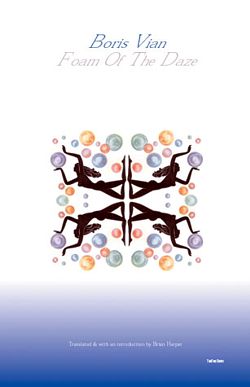 echoes other literary machines such as the “heart-snatcher” in Boris Vian's Foam of the Daze (a constant, explicit referent in the novel) or Haruki Murakami's homemade machine for killing abusive men in 19Q4. But whereas these literary machines mete out death, JE's machine measures time: “[e]mpecé a medir. Empecé, como se dice, a datar. Puertas, muebles, trastos, gomas, cortezas” (54).
echoes other literary machines such as the “heart-snatcher” in Boris Vian's Foam of the Daze (a constant, explicit referent in the novel) or Haruki Murakami's homemade machine for killing abusive men in 19Q4. But whereas these literary machines mete out death, JE's machine measures time: “[e]mpecé a medir. Empecé, como se dice, a datar. Puertas, muebles, trastos, gomas, cortezas” (54).
JE discovers a number of different times overlapping in futuristic Havana, recalling the palimpsest that José Quiroga has invoked to describe contemporary Cuba. There is, to begin with, the time of fashion: “Viejos jeans míos, cadavéricos y rasgados en las rodillas, databan del principio de la era grunge” (54), while brassieres date back millions of years (55). Indeed JE finds women's lingerie to be, without exception, prehistoric: “Maidenform, Wonderbra, Victoria's Secret, Blanquísimas Mofetas…. Las marcas que se me ponían delante. Sin novedad. Es decir, todo en la tienda era nuevo, pero era nuevo desde hacía muchísimo tiempo. Seguí sumando millones y millones de años en una repetición de cansancio” (65-66). The allusion to Reinaldo Arenas' El palacio de las blanquísimas mofetas serves to confirm that the shop that JE has entered, named El Palacio and located on San Rafael, is in some split-reality way both a department store and a clearinghouse for prior literature. It is, in fact, in the department store's inexplicable library on the fifth floor that JE encounters both bras and “de todo,” including “conceptos abstractos.”
What JE (Jorge Enrique) parodies here is therefore not only fashion's tireless production of the new — yielding more of the same — but the predicament of how to write the future without looking dated, without becoming passé. As soon as one cites a particular brand one has entered the fatal cycle of fashion, in which styles burst forth, age, and become a form of embarrassment. Even the novel's own pop-cultural references inevitably already feel curiously aged (the White Stripes, Sex and the City), and indeed the very genre of cyberpunk it cites (though cyberpunk has proven curiously resilient).(5)
JE quickly perceives fashion's proximity to death, as Giacomo Leopardi famously noted in his Dialogue Between Fashion and Death, better known today through Walter Benjamin's meditation on the idea in his Arcades Project. A mannequin in an unfortunate black lingerie turns out to be Sarah Jessica Parker, only aged: “un cuerpo que alguna vez fue el cuerpo de Sex and the City pero ahora era solo Sarah Jessica Parker. Le dije: — Hola, Sarah. Todavía te ves bien. — Mentiroso. Estoy acabada. — Como ha pasado el tiempo, ¿no?”(66).
The morbid nature of both fashion and humanity is further commented upon by vultures (buitres). More than a mere trope in the two books, vultures become Lage's signature symbol, promising to be a key to his oeuvre. But such a promise is itself suspicious in a post-allegorical moment: on planet V— for vulture presumably — “no hay alegorías” [89]). Carbono 14 and Vultureffect rather unfold under the spell of an updated Russian formalist V-effect no longer about making the familiar strange in order to waken dulled senses (a goal also of traditional science fiction) but about incorporation: a feasting on corpses (of fashion, outdated ideologies, and a sick planet) to feed our present.(6) The turning of the dead into the living, however morbid, offers the chance of renewed life breathed into old ghosts.
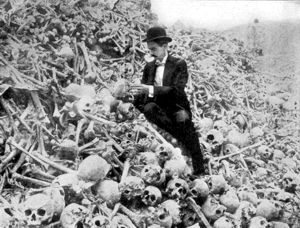 This sustained conceit manifests in Carbono 14 not only in the figure of the buitre but in the construction of a neighborhood on top of what once was Havana's Cementerio Colón, “como si se tratara de llenar una especie de vacío” (41). In more realist novels from the turn of the millennium, such as Antonio José Ponte's 2002 Contrabando de sombrasor Pedro Juan Gutiérrez's 1999 Rey de la Habana, deprivation led desperate grave robbers to loot the Cementerio Colón. In Lage's future not only these spoils but the human remains themselves are gone: “ya no hay restos humanos ni de ningún tipo. Todo ha sido convenientemente saqueado y removido” (139). There are no more treasures to be raided, only multitudes wandering the burial grounds.
This sustained conceit manifests in Carbono 14 not only in the figure of the buitre but in the construction of a neighborhood on top of what once was Havana's Cementerio Colón, “como si se tratara de llenar una especie de vacío” (41). In more realist novels from the turn of the millennium, such as Antonio José Ponte's 2002 Contrabando de sombrasor Pedro Juan Gutiérrez's 1999 Rey de la Habana, deprivation led desperate grave robbers to loot the Cementerio Colón. In Lage's future not only these spoils but the human remains themselves are gone: “ya no hay restos humanos ni de ningún tipo. Todo ha sido convenientemente saqueado y removido” (139). There are no more treasures to be raided, only multitudes wandering the burial grounds.
With no more cemetery in LH bodies are no longer interred, making them easy pickings for the vultures, or ripe for a second life as the undead. Evelyn wonders aloud how the city gets by without a cemetery, a discussion that highlights planet V's zombi-like recombination of body parts — the incorporation of a past that can no longer be recalled in its original form: “¿Qué hacen con los cadáveres si no hay cementerio? — Ah, con los cadáveres se pueden hacer muchas cosas. — Quemarlos. — Por ejemplo. — Poner y quitar partes. — Ok. Has visto Prehistorias. — Olvidarse de ellos. — Por supuesto. — Recordarlos. — Recordar los fluidos que contenían, más bien. — Hablando de recordar, yo no recuerdo mucho de mi planeta" (42). Ponte's own 2010 essay Villa Marista en plata: arte, política, nuevas tecnologías underscored how, in the Raúl Castro era, an uncanny return of the worst repressive specters from the “quinquenio gris,” the “pavonato” era of harsh cultural policy, have returned on at least one occasion like ghosts not laid to rest. Lage's living dead may similarly be the result of a cemetery — a past — evacuated but not dealt with.
Planet Cuba
“Yo no recuerdo mucho de mi planeta:” Evelyn's confession might be a joke about exilic nostalgia, writ large, or a dream for a future in which Cuba's outsized aspirations would be but a distant memory. “Planet,” that staple of science fiction alternate worlds, also invokes the universality of challenges today — human actions have wrought fully planetary change — and suggests the residual consumerist fantasy that ours is only one planet, disposable, among many more.(7) Citing both a long tradition of fantasies about other planets, and more specifically Douglas Coupland's 1992 Shampoo Planet, often read as an indictment of consumer culture and environmental destruction, Lage links Carbono 14 not only with Coupland's concerns but with a style designed to capture North American consumer culture of the 1980s.(8) It was a moment suffering its own post-revolutionary flatness: after the 1960s of the protagonists' parents' generation, the intimations of U.S. decline emerged, which, viewed with the hindsight furnished by the two decades since Shampoo Planet's publication, now can be read as the beginning of the post-American era, as capital began to move to Asia.
Yet if Coupland provided the easy reference, a number of notions of planet — from the given singularity of planet earth to the potential multiplicity of viable planets —are explored in Carbono 14.(9) At one point JE stops by a video store named Planet DVD. This is the 1990s notion of Planet, a shorthand for global business: such commercial “Planets” turn a vision of a lifestyle into a “universal” experience that would dot the globe with identical, yet different, iterations. (The chain of restaurants founded in 1991 as Planet Hollywood joined with AMC Theaters in 1997 to develop Planet Movies, and 1998 launched a short-lived ice cream store, Cool Planet.)
But planet is a capacious term, and Lage avoids reducing it here to mere merchandising. More promising, for instance, is the idea that a city may be a virtual world unto itself, a universe with its own freedoms and cultural topographies, and Lage's LH is both culturally limitless and bounded by water. This notion of the city-as-planet-unto-itself — and indeed the city has proven a uniquely utopian space in literature (Jameson 4) — bumps up against a more ecological reflection on planets: “— Lo malo es que cuando uno se cansa de todas las ciudades no hay otro planeta adónde ir,” one character comments, reminding us both of how world class cities can becomes virtual planets, and of the perils of conceiving of our planet as disposable (23). Meanwhile, any of the island's residually planet-sized airs are quickly deflated in a comic exchange: “Mencionó una explosion...Cuba. — ¿Qué es eso? — Así se llamaba mi planeta. [-] Le dije que jamás había oído hablar de él” (51). Indicating the depth of contemporary weariness with Cuban exceptionalism, this joke is strikingly similar to one uttered, a year after Carbono 14 was published, in Alejandro Brugués' 2011 zombi spoof Juan de los Muertos. Actor Andros Perugorría, exasperated, recounts how far he hopes to travel from the island: “Yo quiero irme pa'l carajo de aquí y darle una vuelta al mundo. Si me preguntan de dónde soy, diré que de Cuba. Si me preguntan qué es Cuba, diré una islita socialista del Caribe. Si me preguntan qué es el socialismo, les voy a decir que es un sistema instaurado por Fidel Castro hace 50 años. Y si me preguntan quién es Fidel Castro, ¡me quedo a vivir ahí para siempre!” Contemporary art and literature fantasize a happy irrelevance of the island, when not its cosmic destruction.
the idea that a city may be a virtual world unto itself, a universe with its own freedoms and cultural topographies, and Lage's LH is both culturally limitless and bounded by water. This notion of the city-as-planet-unto-itself — and indeed the city has proven a uniquely utopian space in literature (Jameson 4) — bumps up against a more ecological reflection on planets: “— Lo malo es que cuando uno se cansa de todas las ciudades no hay otro planeta adónde ir,” one character comments, reminding us both of how world class cities can becomes virtual planets, and of the perils of conceiving of our planet as disposable (23). Meanwhile, any of the island's residually planet-sized airs are quickly deflated in a comic exchange: “Mencionó una explosion...Cuba. — ¿Qué es eso? — Así se llamaba mi planeta. [-] Le dije que jamás había oído hablar de él” (51). Indicating the depth of contemporary weariness with Cuban exceptionalism, this joke is strikingly similar to one uttered, a year after Carbono 14 was published, in Alejandro Brugués' 2011 zombi spoof Juan de los Muertos. Actor Andros Perugorría, exasperated, recounts how far he hopes to travel from the island: “Yo quiero irme pa'l carajo de aquí y darle una vuelta al mundo. Si me preguntan de dónde soy, diré que de Cuba. Si me preguntan qué es Cuba, diré una islita socialista del Caribe. Si me preguntan qué es el socialismo, les voy a decir que es un sistema instaurado por Fidel Castro hace 50 años. Y si me preguntan quién es Fidel Castro, ¡me quedo a vivir ahí para siempre!” Contemporary art and literature fantasize a happy irrelevance of the island, when not its cosmic destruction.
The strange and wearisome island/planet returns once more in Carbono 14's final section. This is a collection of outtakes Lage subtitles “copy & paste” (recalling Goldsmith's description of “uncreative writing” as writing in an era of copy and paste) and which consist of slightly different versions of episodes that appear in the novel proper. Here JE imagines a harsh and fantastical landscape, a cross between depictions of Mars and Avatar:
--Cuba
--¿Qué es eso?
--Así se llamaba mi planeta.
--Lo conozco—mentí—. Una masa de tierra con océanos oscuros y salobres. Inmensas llanuras sembradas de agujeros, pero no para jugar golf. Cordilleras plegadas como intestinos, lanzando al horizonte destellos de luz mineral…Árboles que extienden sus raíces en la niebla. Grandes bestias atrapadas en sorprendentes cadenas alimenticias. Y unas cuantas lunas muy distantes. Y la fe y el alarido de millones de cubanos lanzados al espacio.
This is Cuba as some sci-fi director might shoot it, or as an early modern conquistador might have drafted it on a fantastical map swimming with monsters. But here the planetary imagination also alludes to our real planet's challenges. Elsewhere in the novel a song by the contemporary band Gorillaz sounds in the background: “Every planet we reach is dead” (81). Lage's citation of this song is at once a reference to virtuality —Gorillaz is the most famous “virtual band” — and a reminder of environmental apocalypse.(10) Similarly, the strange climate of the novel owes not only to the conventions of genre fiction but to global warming: in LH it has never snowed, or it hadn't anyway until that “maldita madrugada en que el clima se volvió loco” (163).
As the line points out, for all its political isolation Cuba is not of course excepted from global trends, economic or climatic. And its environmental future remains in the balance. On the one hand, post-Soviet economic collapse and consequent deindustrialization led to a reduction of fossil fuel use and increased organic farming, fostering a kind of edenic promise in the face of the planet's generally dismal outlook. At the end of the novel Frank tells Evelyn “su planeta es ahora, quizás, el único lugar donde ella estará a salvo” (158).
But on the other hand the legacy of twentieth century industrial agriculture (here Soviet socialism's attempts at “conquering nature”) may well have done more damage than has been accounted for (Díaz-Briquets and Pérez). In an economy increasingly dependent on tourism, mining and oil exploration, what future development awaits? As Antonio Benítez Rojo wrote, “a clean, green development is a possibility in Cuba's future, but is it probable?” (50). Lage's allusion to this urgent question echoes a growing interest by young visual artists, from digital poet and printmaker Samuel Riera's planned (though unrealized) “green” community in Cienfuegos, designed to replace fields overrun with marabú, to photographer and conceptual artist Glenda Salazar's visual and community-based interventions into oil spills and into state exhortations to “produce” agriculture wherever possible, to Liesther Amador's site-specific works.(11)
Seriality, Irreality
Planetary predicaments are one principal narrative thread in Lage interlaced, via the figure of the Tabla periódica, to that of genre and style, particularly seriality, a kind of stand-in for the proliferation of sameness in the global market. Seriality can be boring: a Vultureffect entry entitled “Serial” describes a serial killer filled with ennui. “[A]ntes de terminar una frase ya estoy aburrido de ella,” he claimed, “del espíritu que la amenaza, las mentiras que supone y las conclusiones que conllevará” (30).
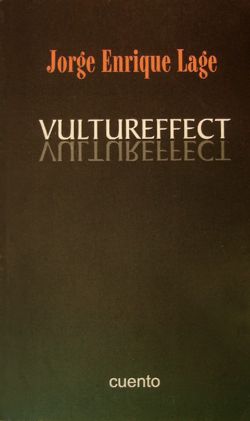 But seriality can also be sublime. Seriality intensifies in the proliferation of television series in Carbono 14 until finally, like some theoretical gas, it undergoes a phase transition separating from any specific series and ascending to a platonic, ethereal seriality: “Y es que en toda la serie de series de televisión ninguna serie se parece a otra, pero hay serialidades que emergen incontrolables. La serialidad siempre está más allá de las televisiones y las teleseries”(49). The dominant series in Carbono 14, one both material and virtual, is the sequence of Evelyns — virtual stars produced by the television series — who populate the novel and turn up every time JE attempts to date lingerie. By the end of the novel we have met twelve Evelyns (Evelyn number 12 is reading a book titled Carbono 14), suggesting a series that may end in Carbono 14 itself, skipping the inauspicious number 13 like an elevator in a high rise.
But seriality can also be sublime. Seriality intensifies in the proliferation of television series in Carbono 14 until finally, like some theoretical gas, it undergoes a phase transition separating from any specific series and ascending to a platonic, ethereal seriality: “Y es que en toda la serie de series de televisión ninguna serie se parece a otra, pero hay serialidades que emergen incontrolables. La serialidad siempre está más allá de las televisiones y las teleseries”(49). The dominant series in Carbono 14, one both material and virtual, is the sequence of Evelyns — virtual stars produced by the television series — who populate the novel and turn up every time JE attempts to date lingerie. By the end of the novel we have met twelve Evelyns (Evelyn number 12 is reading a book titled Carbono 14), suggesting a series that may end in Carbono 14 itself, skipping the inauspicious number 13 like an elevator in a high rise.
But do these series ultimately yield change or more of the same? The micronarrative “Vultureffect” reads: “De pronto veo variaciones, perversiones, declinaciones de un efecto habitual. Movimientos. La policía está en la calle. En la calle se respira el malestar por la policía. El buitre me dice: ‘Aquí va a pasar algo’” (66). Variation, perversion, and declination are new versions of familiar maneuvers by the police. When the vulture says “something is going to happen here,” then, his oracular pronouncement is both a redundant stating of the obvious, and optimistic: no one needs the vulture's commentary to know that more of the same will unfold. And yet the idea that something (new) will happen is the basis for hope.
Seriality is closely tied to the novel's interest in code more generally, beginning with the question of what genre Carbono 14 itself belongs to: cyberpunk? A parody of the Japanese hentai yuri (lesbian porn) that JE sees in a store? A version of the fanfic he mentions? (Can there be fanfic that does not derive from an original?) This generic inscrutability or novelty is alluded to when one of the Evelyns is seen reading a manual “(¿pero de qué?” wonders JE), something she deems “not bad, but not a cult novel either” — cult novel of course is the self-describing subtitle of Carbono 14 (122).
Whatever its genre, Carbono 14 does not attempt realism's characterological “interiority.” It is instead interested in surfaces and exteriors that repel or refuse intimacy. Buitre Frank's best friend, for instance, is a hedgehog, an animal defined by its spiny quills warding off proximity. Sex in the novel is likewise characterized more by surfaces than by the largely unappealing scenes of penetration. But the novel preemptively parodies those philosophers a critic might marshal to describe this style, particularly Gilles Deleuze: buitre Frank is a risible figure who describes things as “becoming-animal.” Still, the novel's interest in surfaces does recall the philosopher of the fold. The protagonist's quest to date women's undergarments (ropa interior) can be seen as a sustained joke to this end, since JE is trying to understand the ancient temporality of women's interiority, or something close to it: “La ropa interior femenina es una superficie. La última superficie antes del cuerpo” (80). Underwear is a last line of defense against penetration, parodied in extreme in an encounter between JE and a robotic woman.
In this comic scene, JE and his robot date are at the movies, and as he begins surreptitiously to move his hand up her thigh in order to carbon-date her underwear, she sucks his machine up inside her. JE goes after it, reaching first one hand, then two, then eventually his whole body inside her in search of his missing kit. Once inside her JE reflects “¿Qué tienen de especial estos interiores?” (83). Do robots have interiority? Do humans?
Contrast this glib “interiority” with its slightly more traditional exploration in contemporary Cuban author Wendy Guerra's poem “Ropa interior” from her eponymous 2008 collection. Guerra's “Ropa interior” similarly vests interiority in women's undergarments, but the interiority is of a more lyric poetic kind: “En ropa interior leemos nuestras páginas persiguiendo sólo su deseo" /…/ Soy mi texto y lo que trato de ocultar en el peligro de la superviviencia / ropa interior en frasco de otro baño / otra humedad mucho frío /… Sólo en ropa interior logro salvarme” [27-28]). In contrast with Guerra's exploration of interiority, Lage exposes how genre works.
As JE searches in the dark cave of the robot's vagina for his missing machine, the robot scrutinizes the film projected in the dark cave of the theater, commenting that rumors are circulating that the film “holds the keys” to the possible retirement of star Evelyn Z. JE comments, “No es que me gustara hablar solo en el interior de una espectadora para quien una película de género era un texto con información encapsulada” (84). While mocking the idea of a genre film as a possible source of genuine information, JE underscores how genre does in fact depend on discrete pieces of information that precisely identify an artwork as belonging to this or that genre. The episode also underscores a lack of “interiority” in genre fiction, since the interior of the robot houses JE (or Jorge Lage). There is no subjectivity to be dragged out and examined.
Lage returns to this idea later in the novel when he stages a meta-satire of language's evacuation in a passage about Frank:
Junto a otros como él de otras desbandadas sin nombre (pero 'desbandada' ya es un nombre y un sistema), se dedica a satirizar las sátiras gobernantes como quien lo hace en serio. Se vuelve metasatírico, lo cual es más o menos absurdo….Trabaja rodeado de alarmas. Lo de menos es la paranoia…Lo que de verdad preocupa a Frank es que en algún momento tenga que abrir la boca y que de su boca salga la frase correcta…Las palabras sobre la mesa.—EL JUEGO DE LAS PIEZAS ÍNTIMAS HABÍA LLEGADO A UN PUNTO MUERTO--…Lo meten preso. Lo ayudan a escapar, se defiende. Pero su genoma ya no está en las listas de derechos humanos y de otros derechos (el de hacer otras listas). O sea, que ya es un monstruo. (142)
Satirizing satire may be the only means of restoring sincerity to a bankrupt genre. The game of carbon dating piezas íntimas (JE's tale) is dead, but so too are classical satire and realism's simulation of characterological interiority, the Tabla suggests. Sincere satire belongs to an earlier era, and vulture Frank to a biopolitical future. Thus while Frank is incarcerated for his political satire, satire's ineffectiveness is evidenced by the fact that he is helped to escape by those who imprison him. In this post-allegorical world, one can satirize repression all one wants, but little changes. (12) Frank is less afraid less of censorship than that his interiority — his “intimate pieces” — may be exposed. In the end, finally, it is not prison but utter banishment that haunts Frank, who is deemed a true monster. In this future, DNA is the ultimate code and form of control, alluded to through a citation of the film GATTACA, in which DNA itself is subject to programming (113).
The convergence of these two codes — the biochemical and the linguistic — is thematized by the Tabla periódica. It is a convergence actually realized today by writers such as the Brazilian artist Eduardo Kac (author of transgenetic poems) or the Canadian poet Christian Bök, whose Xenotext is a poem translated into genetic code and inserted into the DNA of E. Coli, who in turn produce another text. The poet cedes the process of creation to a code-making machine. Similarly, the “fanfic” Lage evokes involves a massive democratization of writing and ceding of authorship. And Carbono 14's own efforts at “uncreative writing” are alluded to slyly when JE is caught with a pile of women's “piezas interiores”: “Nada de eso es mío” he hastens to explain, embarrassed. “Claro que no. Lo robaste,” answers an Evelyn (100).
Foam, Gas, Fragments, Forbears, Futures
It is not only television shows like Futurama or rock lyrics (or women's lingerie) that are “stolen” in Carbono 14. Literary forbears are also appropriated effortlessly. The novel evinces a voracious incorporation, a folding in of literary luminaries, masticated and spit back with a wink at the reader. Language has been exhausted, and yet we must continue to use it. It is a poetics satirically sketched out in an exchange between Evelyn and Guillermo Caín (Guillermo Cabrera Infante's pen name when he wrote film criticism for Carteles):
La ciudad es interminable, ¿no cree? –Primero que todo, yo no usaría más la palabra 'ciudad' ni la palabra 'interminable,' pero entiendo lo que quieres decir.-Quiero decir que llevamos un día caminando y nada de esto se repite.-Se repite el mar.-Cierto, el mar.-A la gente se le olvida. Es una especie de requisito.-Quizá el mar lo rodea todo.-Estás hablando de una isla.-Sí.-¿No es un poco pesado ponerse a hablar de una isla?-No. (40)
Caín suggests that while everything about Evelyn's language is linguistically bankrupt, he understands her nonetheless. What does he understand? That the city contains unending possibilities, limited only by the water. But even this meditation on infinity and its restrictions turns out to be a joke about the limited possibilities for literary innovation, playing on Virgilio Piñera's poem “La isla en peso” about “la maldita circunstancia del agua por todas partes” (“No es un poco pesado ponerse a hablar de una isla?”).
The solution then is not to escape the insular tradition by attempting to never again utter the word “city” or “interminable” — or “sea” or “island” — but to cite it in passing. Clichés receive new life when treated homeopathically: embrace a little and they lose their power. So the Long brothers themselves morph into the cliché of their national film genre: they begin quarreling on the set, their professional tensions lead to physical violence, “y ya que estaban en eso, pues a grabar escenas de artes marciales” (44). In other words, don't bemoan the cliché, belabor it, exploit it, sell it, and go beyond it into reality, as in the split moment in which Evelyn stops acting as if she were strangling her co-star and strangles him in earnest; the actor in turn “dejó de fingir que era un personaje que debatía por respirar…hasta convertirse en un personaje estrangulado” (46).
The question of what a break into “irreality” would look like addresses both representation in an era of simulation and the larger question of how to imagine transitions. When does acting turn into reality? Can you transit from the virtual to the real without killing off the actor himself? The novel offers several examples of transitions. Evelyn Number Nine, for instance, appears as a private detective in man's drag, a “Pre-op FTM princess” (107). Sex change is one kind of transition, futuristic cuerpos virtuales another, exploding planets another still. Transitions abound. But transitions to what? As one robot puts it, “¿qué es lo que viene después?” (109)
larger question of how to imagine transitions. When does acting turn into reality? Can you transit from the virtual to the real without killing off the actor himself? The novel offers several examples of transitions. Evelyn Number Nine, for instance, appears as a private detective in man's drag, a “Pre-op FTM princess” (107). Sex change is one kind of transition, futuristic cuerpos virtuales another, exploding planets another still. Transitions abound. But transitions to what? As one robot puts it, “¿qué es lo que viene después?” (109)
It is the answer to this question that the robot seeks in the movie theater scene cited above. She explains, “Últimamente han venido a pedirme que investigue el fin de la última Evelyn. Gente que quiere saber si son ciertos los rumores, si el retiro es inminente. Gente que quiere saber cuándo. Gente que quiere hacerse una idea de lo que viene después” (109). It's not hard to see in these lines both a commentary on the vapidity of celebrity culture and a description of a collective awaiting for a post-Castro future. Even the term “what comes next” is again similar to a phrase used in Juan de los Muertos for post-Special Period Cuba: “esta cosa que vino después,” whose present tense suggests that the “día después” is already upon us, yet remains inscrutable or unnameable, rendered only in the exaggerated strokes of “B” genres (de la Nuez).
The novel also seeks to uncover what came before. Cabrera Infante, disguised as Caín, claims to work at a magazine Poster(s), an Anglicization of the historic Carteles (37). This posthumous writer for Poster(s) is a joke about the legacy of literary forbears: Poster(s) — “Con ese entre paréntesis al final” (42) — manages to also parody earlier literary groups Diaspora(s) and Cacharro(s). Lage has acknowledged Diaspora(s) respectfully but humorously in an interview; he has published with former members of Cacharro(s). Other influences parade through the novel: Phillip Marlowe and Phillip K. Dick, Ronald Sukenick, member of the U.S.-based 1980s experimental Fiction Collective (a significant group in Porta's genealogy of "afterpop" as well), and notably Boris Vian.
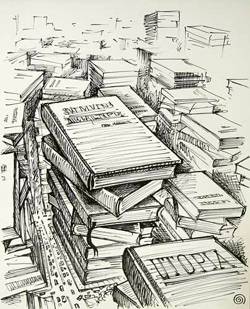 Vian's The Foam of the Daze is indeed cited several times and shares in both style and in content. Carbono 14 abounds in flows — not only the copious amounts of blood and gore proper to a “cult” novel, but sexual fluids and the flows of illegal networks: narcotics, stolen goods, even body parts (a room in a hotel is priced at “la extracción de un órgano de vital importancia” [112]). From Carbono 14's meditations on blood, melted chocolate, vaginal fluids, semen, and the ocean, Lage makes the clever connection to “espuma” or foam, a citation as well as a kind of allegory, a la Peter Sloterdijk's bubbles in his giant Sphären trilogy, symbols of a globalized planet. Suddenly the froth kicked up by the waves against Havana's Malecón becomes the best image for other possible worlds, infinite, spherical, serial, and unexplored.
Vian's The Foam of the Daze is indeed cited several times and shares in both style and in content. Carbono 14 abounds in flows — not only the copious amounts of blood and gore proper to a “cult” novel, but sexual fluids and the flows of illegal networks: narcotics, stolen goods, even body parts (a room in a hotel is priced at “la extracción de un órgano de vital importancia” [112]). From Carbono 14's meditations on blood, melted chocolate, vaginal fluids, semen, and the ocean, Lage makes the clever connection to “espuma” or foam, a citation as well as a kind of allegory, a la Peter Sloterdijk's bubbles in his giant Sphären trilogy, symbols of a globalized planet. Suddenly the froth kicked up by the waves against Havana's Malecón becomes the best image for other possible worlds, infinite, spherical, serial, and unexplored.
Fluidity also parodies Deleuzian flows: “El devenir-espuma es interesante, como todo devenir-coloide, pero ahora lo que se impone es el devenir-lingerie de la escritura” Frank comments (68). This becoming-lacy literature is an embrace of erotica as much as a subtle nod to Republican-era author Enrique Labrador Ruiz, smuggled in behind the more obvious reference to Vian. If Frank cribs from Vian when he writes “Hay que escribir espuma,” when he adds “Siempre el gas y el líquido revueltos” he may well be invoking Labrador Ruiz's 1930s “novelas gaseiformes”(68).
Toward the end of Carbono 14 a washing machine begins generating suds (espuma) and JE describes himself and Evelyn circling around inside it: “giramos. Yo sentí que me fragmentaba. Mis moléculas se convirtieron en peces nadando contra la fuerza del agua” (123). There is a sense that this process is what produces Carbono 14's “outtakes” and the eventual book of fragments Vultureffect, as if the 2011 collection of stories were the result of the ultimate decomposition of Carbono 14 into pieces. In one of Vultureffect's micronarratives entitled “Groenlandés” Lage writes that the relevance of rock music today owes precisely to the fact that it has “done us the favor” of disappearing, leaving its parts available for new creations; “...con su restos, con sus pedazos, yo estoy haciendo escritura” (12). With these fragments of outmoded art, like, perhaps, the chemicals in the Tabla periódica, Lage is making something new.
Homo XBOX
The frothy, lacy, comic writing is light-hearted, but also serious in what it considers. What constitutes play in the twenty first century? This seemingly banal query harbors within it the profound question of what free time means in an era of so-called affective labor, a moment in which corporations' marketing strategies cull strategic information from our game-playing on social media. While this is the global context for the issues explored in Lage's futuristic world, the more local one compounds these questions with the almost diametrically opposed challenge of what “diversion” means in an authoritarian state where diversión is not to be confused with, yet is not so distant either from charges of ideological straying.
The question of play weaves throughout both Carbono 14 and Vultureffect, beginning with the latter's first entry, “Perdidos,” a title that plays on the premise of the series “Lost,” that hypothetical, Crusoe-like situation of being stranded on a tropical island:
No tenemos nada, pero tenemos un balón de fútbol. En lugar de quedarnos tranquilos viendo un partido de fútbol o viendo la serie Lost, nos vamos a correr y a darle patadas al balón. Sentados a la sombra, unos niños nos preguntan si pueden jugar con nosotros. Yo les digo que no estamos jugando…. Definitivamente no es un juego….Nos destrozamos los zapatos y los tobillos, empezamos a deshidratarnos, a considerar el cansancio, la desesperación. (5)
At first the parable seems to redeem the simple pleasures of physical play in place of the more mediated but passive ones of watching broadcast games or television series. But this cliché of making do — the best things in life are free, etc. — is quickly exposed as a cheap patina laid over the violent undercurrents of society and the militaristic origins of games, as Ed Halter has excavated deftly in his book From Sun Tzu to Xbox: War and Video Games. Indeed, the apparent game is not a game at all, but a contest unto death, a fighting over scraps, a kind of Lord of the Flies situation that Lost and other fictions echo, and plausibly a reference to post-1989 Cuban society.(13)
“Perdidos” is a koan-like take on what Lage describes at greater length in Carbono 14 through the symbol of the amusement park, a site I have discussed elsewhere as a privileged one for reflections both architectonic and literary on temporality, political economy and desire in Cuban history. Again the aging amusement park becomes an allegorical space for describing society, something Antonio José Ponte has called a “parque temático de la Guerra Fría” (FV 67).(14) The portentously named “Villa S” in Carbono 14 (recalling the sinister Villa Marista, seat of Cuba's state security) is an abandoned park that has acquired “a certain air of a military zone” (103). The fields, whether for play or military exercises, are in ruins: “Zoom in: una montaña rusa que se cayó en pedazos, carruseles donde gira el óxido, desarmados puestos de venta…columpios estrangulados en sus propias cadenas, avioncitos estrellados…” (103-4). The swings strangled by their own chains are only the first indication that the site of intended “fun” can easily flip into the sinister; rides are later called “torture apparata” unable even to evoke nostalgia for some happier past:
Cuando veo todos estos aparatos de tortura en lo que menos pienso es en el pasado que pueden contener, la diversión y la gritería que pueden haber presenciado. Dije que, sin duda alguna, los tiempos habían cambiado y ahora los niños tenían otras diversiones en que invertir el tiempo. Frank siguió:--Es como si aquí no se lograra recordar ningún pasado. Automáticamente se piensa en el futuro. Y si hay algo que no conviene olvidar es el futuro. Remember the future!, dijo Ronald Sukenick.—¿Quién?—Haría falta poner en varios canales de esta zapping city carteles que avisen: FUTURO…Frank terminó confesándome que un parque de diversiones destruido (o un parque de diversiones destruidas) tampoco le hacía pensar en niños:--Aunque algo queda de la atmósfera de juego, de orden desordenado, de dar vueltas y marearse o perderse. Pero ahora con criaturas distintas. Tienen que serlo. (104)
The ruined amusement park or “Villa” containing torture equipment recalls not innocent childhood but the ruins of ill-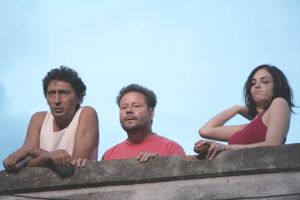 conceived attempts to force the future. It is not an occasion for nostalgia but for recognizing a new era of gaming; a virtual one that produces “new creatures/children” with new ways to “spend time.” Lage manages to fuse here twenty-first century capitalism's culture of play for profit with late- or post-socialism's culture of underemployed ocio, both curious perversions of Paul Laforgue's tract on the “right to idleness” (Jameson 150).
conceived attempts to force the future. It is not an occasion for nostalgia but for recognizing a new era of gaming; a virtual one that produces “new creatures/children” with new ways to “spend time.” Lage manages to fuse here twenty-first century capitalism's culture of play for profit with late- or post-socialism's culture of underemployed ocio, both curious perversions of Paul Laforgue's tract on the “right to idleness” (Jameson 150).
But the new forms of play remain indeterminate: in Carbono 14 play doesn't extend much beyond familiar video gaming. A character named Peter pop invites Evelyn to play with his Playstation, "much better than a Tabla periódica" (177). The game appears to be a standard strategy game in which players build a universe from a primeval soup, here a “prehistoric” scene (with echoes of Evelyn's home planet). “Cada level es un ecosistema extraño. De todas formas no se sabe bien en qué planeta estamos. ¿Me sigues? En la hoja hay una lista. Humanos, pero de otras especies humanas, algunas extinguidas: homo floresensis, homo katie Holmes, homo neanderthalensis, homo antecessor, homo wii, homo xbox” (177-8). This description of a standard video game trope (alien planets, unknown ecosystems) is a parody of Cuban being-outside-of-time, but it also speculates on a global new “species” of homo ludens: humans shaped by their Wii's and Xboxes, their new forms of “play.” We do not know what planet we are on at the end of Carbono 14, but it is one in which the way we spend time will be different.
Notes
1. My thanks to the anonymous readers of the article, to Jorge Enrique Lage and to Jacqueline Loss for their comments.2. Espinosa Domínguez used the term “posrevolucionaria” in a 2006 article on contemporary Cuban authors (including Lage), referring in turn to Jorge Fornet's description of “posrevolucionaria” literature as that which was unpreoccupied with the past or future of the revolution. Fornet had used the term in 2002 to describe an emergent, twenty-first century generation of writers who “no parecen desencantarse de nada, porque nunca llegaron a escribir obras marcadas por el encanto. La mayor parte de ellos realiza, más bien, una literatura posrevolucionaria, en el sentido de que la historia y el destino de la Revolución misma no parecen preocuparles” (25).
3. For recent histories of Cuban science fiction see Yoss's Crónicas del mañana 50 años de cuentos cubanos de ciencia ficción and N.V. Román, Universo de la ciencia ficción cubana.
4. In “Narrativa cubana contemporánea: cuatro cuentistas jóvenes,” Carlos Espinosa Domínguez also signaled this tendency towards fragments in his analysis of a broader (and somewhat older) generation sample of Cuban short story authors in which he nonetheless include Lage.
5. See James Patrick Kelly, “Who Owns Cyberpunk?”
6. Science fiction critic Darko Suvin famously conceived of “cognitive estrangement” as the mode by which true science fiction operates, in order to prompt change or allow for dreams of freedom; Daína Chaviano likewise has argued that for her science fiction was a means to move beyond 1980s limiting strictures.
7. My thanks to Fabio Durão for this insight.
8. Jorge Enrique Lage has claimed that Shampoo Planet was the reference for his own riff on planets (personal communication.)
9. Jorge Enrique Lage, personal communication.
10. Gorillaz is a virtual band conceived as both critique and beneficiary of the virtual, mediated nature of the current music industry and culture industry more generally.
11. For examples of works by Glenda Salazar and Liesther Amador see El extremo de la bala: una década de arte cubano; Samuel Riera, personal communication.
12. Fredric Jameson has noted that per critic Robert C. Elliott's “great dialectical proposition,” utopian writing is “the opposite and the structural inversion of satire as such” (23). While Lage's work is perhaps better described as dystopian, it too suggests the impotence of satire today.
13. Laura Reduello has also read twenty-first century Cuban literature as depicting a ferocious society in “Touring Havana in the Work of Ronaldo Menéndez.”
14. See also Ivan de la Nuez's similar concept in his introduction to Cuba y el día después: doce ensayistas nacidos con al revolución imaginan el futuro and Jacqueline Loss's use of it in “Global Arenas: Narrative and Filmic Translations of Identity.”
Works Cited
Altunaga, Rewell, curator. El extremo de la bala: una década de arte cubano. La Habana: Asociación Hermanos Saíz, 2011. Print.
Bellatin, Mario. Biografía ilustrada de Mishima. Buenos Aires: Entropía, 2009. Print.
Benitez Rojo, Antonio. “Sugar and the Environment in Cuba.” Trans. James Maraniss. Caribbean Literature and the Environment: Between Nature and Culture. Eds. Elizabeth DeLoghrey, Renée K. Gosson and George B. Handley. Charlottesville: University of Virginia Press, 2005. Print.
Bök, Christian. "The Xenotext Works." Poetryfoundation.org. April 3, 2011. Web.
Chaviano, Daína. “La fantasía y la ciencia ficción como espacios de libertad,” in Cuba:La revolución revisitada. Eds. Andrea Gremels and Roland Spiller. Tübingen: NarrVerlag, 2010, pp. 249-258.
De la Nuez, Iván. “El Hombre Nuevo ante el otro futuro,” in Cuba y el día después: doceensayistas nacidos con la revolución imaginan el futuro. Barcelona: Mondadori, 2001, pp. 9-20.
Díaz-Briquets, Sergio and Jorge Pérez. Conquering Nature: The Environmental Legacyof Socialism in Cuba. Pittsburgh: University of Pittsburgh Press, 2009. Print.
Espinosa Domínguez, Carlos. “Narrativa cubana contemporánea: cuatro cuentistas jóvenes.” Greeley, CO: Confluencia, Vol. 22 No. 1 (Fall 2006), p. 218.
Fernández Porta, Eloy. Afterpop: la literatura de la implosión mediatica. Córdoba: Editorial Berenice, 2007. Print.
-----. Homo sampler. Barcelona: Editorial Anagrama, 2008.
Fornet, Jorge. “Prologo,” in Jorge Fornet y Carlos Espinosa Domínguez, eds. Cuento cubano del siglo XX. México: Fondo de Cultura Económica, 2002.
Goldsmith, Kenneth. Uncreative Writing. New York, Columbia University Press, 2011. Print.
Guerra, Wendy. Ropa interior. Barcelona: Bruguera, 2008. Print.
Gutiérrez, Pedro Juan. El rey de la Habana. Barcelona: Editorial Anagrama, 1999. Print.
Halter, Ed. From Sun Tzu to Xbox: War and Video Games. New York: Thunder's Mouth Press, 2006. Print.
Jameson, Fredric. Archaeologies of the Future: The Desire Called Utopia and Other Science Fictions. New York: Verso, 2005. Print.
Juan de los Muertos. Dir. Alejandro Brugués. La Zanfoña Producciones, 2011. Film
Kelly, James Patrick. “Who Owns Cyberpunk?,” in Strange Divisions and Alien Territories the Sub-genres of Science Fiction, ed. Keith Brooke. New York: Palgrave McMillan, 2012, pp. 144-155. Print.
Lage, Jorge Enrique. Carbono 14: Una novela de culto. Lima: Ediciones Altazor, 2010. Print.
-----. Interview by Claudia Apabaza. “Lo que me preocupa es cómo desarrollar una obra literaria lo más vital posible y de la que me sienta satisfecho.” Literaturas.com, 2010. Web.
-----. Vultureffect. La Habana, Ediciones Unión, 2011. Print.
Loss, Jacqueline. “Global Arenas: Narrative and Filmic Translations of Identity,” Nepantla: Views from South 4.2 (2003): 317-344. Print.
Murakami, Haruki. I984. Trans. Jay Rubin and Philip Gabriel. New York : Alfred A. Knopf, 2011. Print.
Pardo Lazo, Orlando Luis. Boring Home. La Habana: Ediciones Lawtonamar, 2009. Pdf.
Perez Valero, Rodolfo and Juan Carlos Reloba. Confrontación. La Habana: Editorial Letras Cubanas, 1985.
Ponte, Antonio José. Contrabando de sombras. Barcelona: Grijalbo Mondadori, 2002. Print.
-----. La fiesta vigilada. Barcelona: Editorial Anagrama, 2007. Print.
----- Villa Marista en plata: arte, tecnología, política. Barcelona: Colibrí, 2010. Print.
Price, Rachel. “From Coney Island to La Isla del Coco.” Journal of Latin American Cultural Studies, 20:3, Autumn 2011. Print.
Quiroga, José. Cuban Palimpsests. Minneapolis: University of Minnesota Press, 2005. Print.
Reduello, Laura. “Touring Havana in the Work of Ronaldo Menéndez,” in Havana Beyond the Ruins Cultural Mappings after 1989(Durham: Duke University Press, 2011), pp. 229-248. Print.
Román, N.V. Universo de la ciencia ficción cubana. La Habana: Ediciones extramuros, 2005.
Vian, Boris. The Foam of the Daze. Trans. Brian Harper. Los Angeles: Tam Tam books, 2003. Print.
Yoss. Crónicas del mañana 50 años de cuentos cubanos de ciencia ficción. La Habana: Editorial Letras Cubanas, 2008.

